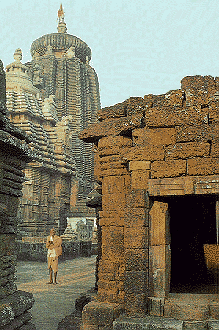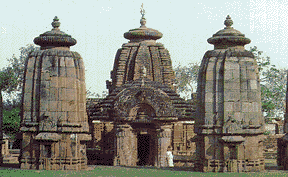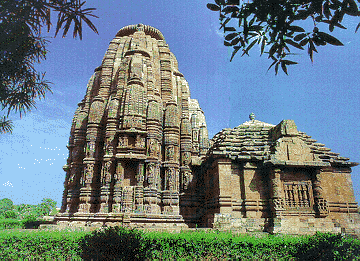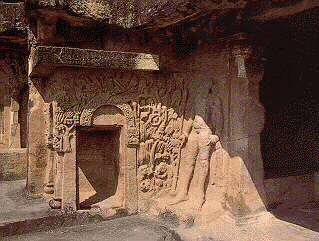![]()
|
Bhubaneshwar The ancient capital of the Kalinga empire, and now the capital of Orissa, Bhubaneswar's history goes back over 2000 years. "Bhubaneshwar" means the "abode of God" or "master of the universe" and it was also, once known as the 'Cathedral of the East', on account of the large number of shrines. At one time, the Bindu Sagar tank was bordered by over 7000 temples. Of these, 500 still survive, all built in the extravagant Oriya style. It is of these temples, that the great poet, Rabindranath Tagore had once said - 'At all places where the eye rests, and also at places where the eye does not rest, the busy chisel of the artist has worked incessantly. The abode of god has been enveloped by a variety of figures depicting the good and the evil, the great as well as the insignificant, the daily occurences of human life....'
Lingaraja Temple Lingaraja Temple, Bhubaneshwar
This temple is a prime example of Indian architecture, in its most mature and fully developed state. The great Lingaraja soars above the city, and dominates the landscape. It dates back to the 11th century, to the time, when the Jagannath cult was at its peak in Orissa. This magnificent temple, 147 ft. high from the plinth, was built by Lalatendu Keshari of Somavamsi dynasty in 617-657 A.D. The 'nata mandapa' (dance hall) and 'bhoga mandapa' (offerings hall), were later added to the temple, that has evolved over different historical periods. By the time, the Lingaraja temple was built, the Jagannath cult had become widespread, throughout Orissa. This is exemplified by the fact, that the presiding deity, here, is the Svayambhu Linga - half Shiva, half Vishnu, a unique feature of the temple. Almost all the Hindu gods and goddesses are represented in this temple, mirroring the inherent element of harmony within the religion. One of the noticeable features of the Lingaraj temple is its degrading architectural beauty, as one retreats from the deul (the Sanctum Sanctorum), away towards the bhogamandir (the hall of offerings). This is so, because the Lingaraja temple was built by the rulers of three dynasties, over a huge span of time. The deul was built by the prosperous Kesari dyanasty. The Muslim invasion, after that, left the Ganga dynasty in a position, that they built the bhogamandir at the cost of its architectural beauty. Parasurameswara Temple The Parasurameswara temple, built in 650 AD, is one of the few oldest surviving temples in Bhubaneswar. The temple built in the Kalinga school of architecture, was dedicated to Lord Shiva but there are images of Lord Vishnu, Yama, Surya and seven Mother goddesses. Lavishly decorated, this it has exquisite friezes depicting animal life, human figures and floral motifs, coupled with impressive busts of Shiva. Just south of Parasurameswara temple is the Swaranajaleswara temple, built in similar fashion, only the motifs on the walls depict scenes from the Ramayana. Vaital Deul (800 AD) Vaital Deul is the shrine devoted to Chamunda (a tantric avatar of Goddess Kali) or Shakti. Seated on a corpse in a dark, inner sanctum is the deity, a garland of skulls around her neck, flanked by a jackal and an owl. The various niches on the inner wall depict equally startling images as also scenes of tantric rituals. It is the first of the temples to depict erotic sculptures, and is also unique in that, that the outer surface of the vault is plain and the interiors are lavishly embellished. Mukteswara Temple Mukteswara Temple
This 10th century temple is an important transition point, between the early and the later phases of the Kalinga school of temple architecture. The sculptural decoration of the Mukteswara is exquisitely executed, and it is often referred to as the "gem of Oriya architecture". Richly sculpted, the temple offers pride of place to tales from the Panchatantra. The niches on the outer face of the compound wall, include Buddhist and Jain images, as well as the Hindu ones, pointing to the unique synthesis, which was so much a part of Oriya life. The highlight of the temple, is the magnificent torana - the decorative gateway, an arched masterpiece, reminiscent of Buddhist influence in Orissa. The temple dedicated to Lord Shiva, Mukteswara, is also carved with figures of ascetics in several poses of meditation. Rajarani Temple Rajarani Temple
Built in the 11th century, the Rajarani temple is famous for its ornate deul, or compass, decorated with some of the most impressive Oriya temple architecture. The temple is remarkable for the absence of any presiding deity. The temple's name is supposed to be derived from the red-gold sandstone used in building it - rajarani being the local name for the stone. The deul is intricately carved with figures involved in daily chores. The lower portion of the deul is populated by statues of eight Dipalakas, guarding the eight cardinal directions of the temple. Between them, nymphs, embracing couples, elephants and lions fill the niches, and decorate the pillars.Set in a picturesque locale, the temple creates a dramatic image against the setting sun. Bramheswara Temple This temple depicts the mature Oriyan school of architecture. The deul and the jagmohana (the porch) are exquisitely carved and for the first time in the history of temple architecture, musicians and dancers appear on the outer walls. Another first is the use of iron beams. In the western end, Chamunda, Shiva and other deities are depicted. The temple houses a living deity, which is indicated by the saffron pennant flying from the top of the sanctuary. Jain caves, Khandagiri
Udaygiri Khandagiri 7 kms from Bhubaneshwar are the twin hills of Udaygiri and Khandagiri. Built by Kharavela around 1st-2nd century BC, for Jain monks, these are fine specimens of Jain Cave art. The famous caves of Hathigumpha (elephant cave) in Udaygiri, Rani Gumpha (Queen's cave) also in Udaygiri, with upper and lower storeys, roomy courtyards and exquisitely designed friezes stand testimony to the level of class the architectural styles had attained as early as the first century BC.
The end of January is the time when the Tribal Fair comes around. February to March, Shivaratri is held at the Lingaraj Temple, Hakateswar Temple Atri and throughout Orissa. Magha Saptami is held at Khandagiri outside Bhubaneshwar. At Ashokashtami, during April/May, the idol of Lord Lingaraja is taken out in procession, part of a chariot festival. Panashankanti (Fire-walking) takes place in various areas on the first day of Baisakh. In June/July, the impressive Rath Yatra takes place at Puri, Baripada and other parts of the state. Kali Puja, in October/November, the city is lit with lamps. Bali Yatra in October/November, a fair is held on the banks of the Mahanadi river in Cuttack.
On the National Highway linking Calcutta (480 km) and Madras (1225 km). Air links to Delhi, Calcutta, Hyderabad and Nagpur. Rail links to Calcutta, Madras, Delhi (1745 km), Bombay(1691 km).
The Oberoi, Kalinga Ashok, Hotel Swosti, New Kenilworth, Prachi, Panthanivas are some of the hotels available for accomodation. |
News | Culture | Economy | Sports | Tourism | Polity | Magazine | Info
Media | Science & Tech. | Social Issues | Foreign Relations | States
What's New | Search | Home



